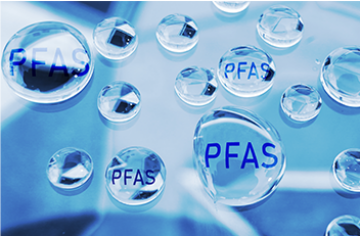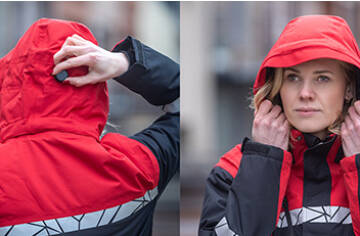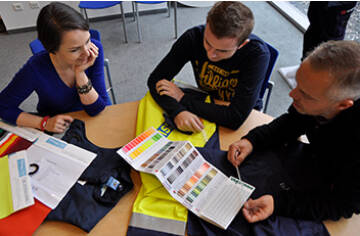
Updated on 21/05/2025.
Anyone looking into protective workwear will soon come across technical terms such as PU coating, Proban® finish or laminate. These may sound like details, but in practice they make a world of difference in terms of protection, breathability and garment longevity.
But, don't worry, it’s easy to stop mixing up these terms. They are very similar so you could easily get muddled but, in practice, each of these treatments has its own specific purpose and protection.
In this article, we explain the difference between a finish, a coating and a laminate.
What is a coating?
In the textile industry, a coating is seen as a clearly visible layer which is applied directly to the material . It often has a plastic-like feel and is easy to spot, especially on the inside of a garment where it is usually white or grey. But it can also be found on the outside, for example in chemical suits.
In practice, most coatings for protective clothing consist of PVC or PU (polyurethane). Some are breathable and allow water vapour to pass through, while others are completely impermeable due to their closed structure.
Note: When sewing a garment, the coating is punctured by the stitching. Water or chemicals can penetrate these seams without additional sealing (such as taping or welding).
A coating is most commonly used for raincoats or jackets for working environments with wet or dirty conditions.
What is a finish?
A finish is an invisible finish/chemical treatment on your garment/fibres. Unlike coatings, you don't immediately see or feel a finish.
The most common finishes for protective clothing are the fluorocarbon and Proban® finishes. They have a direct effect on the protection provided by your garment.
- Fluorocarbon finish: This ensures that water, oil or chemical droplets bead on the surface of the fabric. Unfortunately, the finish is not permanent, so fluorocarbon must be added again after each wash. Restoring this a job for a specialist.
- Proban®: The most famous brand name for an invisible finish that makes your cotton garment flame-retardant. If maintained correctly, this finish is retained for 50 to 100 industrial washes.
One of the most frequently asked questions is how many washes the item can go through and retain a finish that is suitable for professional use? The answer is that it depends on wear and soiling of the clothes. The chemical resistance of a finish depends largely on the material. Dirt, oil and harsh detergents degrade performance faster than the washing process.
What is a laminate?
A laminate is very similar to a coating, but the difference lies in the manufacturing process. A laminate involves first creating an ultra-thin 'film' (membrane), which is then laminated (glued) to the inside of a fabric.
Because the laminate can be made much thinner than direct coatings, it is the ideal solution for breathable garments. The only drawback is the price tag, which is higher due to the complex production method.
Laminate technology is mainly found in high-quality workwear where breathability is crucial, such as jackets for intensive outdoor work in wet and active conditions.
Do you need protection against rain, heat or chemicals? Below is a handy overview to explain which type of finish suits your work.
When should you choose which protection?
Do you need protection against rain, heat or chemicals? Below is a handy overview to explain which type of finish suits your work.
| Coating | Finish | Laminate | |
|---|---|---|---|
| Visible | Yes | No | No |
| Waterproof | Yes | No (limited) | Yes |
| Breathability | Limited (PU) | N/A | Yes (high) |
| Fire-retardant | Both |
Proban®: Yes Fluorocarbon: No |
Possibly in combination |
| Service life | Medium | Depending on maintenance | High |
| Price | € | € | €€ |
Would you like some expert advice on choosing the right finish? Please contact us.
In summary
- Coating: Protective layer on or in the fabric. Waterproof, but sometimes less breathable. Pay attention to the finish of the seams.
- Finish: Invisible treatment of fibres for specific properties, such as flame retardant or chemical repellent finish. Often prone to wear and washing.
- Laminate: Glued breathable film on the inside. Expensive, but light and comfortable.






